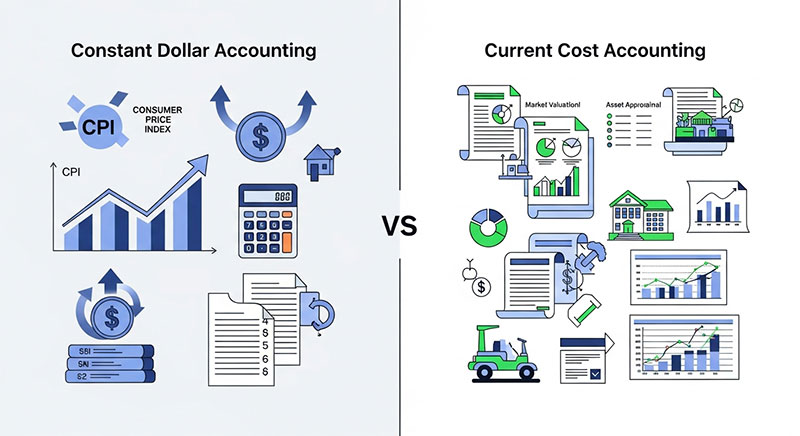Inflation significantly impacts financial reporting accuracy, making understanding current cost accounting vs. constant dollar accounting essential for accounting professionals and CPA candidates. These alternative accounting methods address the limitations of traditional historical cost accounting when dealing with changing price levels and economic conditions.
Both current cost accounting and constant dollar accounting are inflation accounting techniques designed to provide more relevant financial information. While historical cost accounting records transactions at their original purchase price, these methods adjust financial statements to reflect changing economic conditions, ensuring a more accurate representation of a company’s financial position.
Understanding Inflation’s Impact on Financial Reporting
Traditional historical cost accounting fails to capture the real economic impact of inflation on business operations. When inflation occurs, the purchasing power of money decreases, making historical cost figures less meaningful for decision-making purposes. This becomes particularly problematic for companies with significant long-term assets, where the gap between historical costs and current values can be substantial.
The accuracy of a company’s financial statements becomes increasingly distorted as inflation rises, particularly affecting entities with substantial long-term asset holdings.
Consider a manufacturing company that purchased equipment ten years ago for $100,000. With a cumulative inflation of 25%, the equipment’s current replacement cost would be approximately $125,000. However, traditional accounting continues to report the asset at its depreciated historical cost, potentially understating the true investment required to maintain operational capacity.
Constant Dollar Accounting: Methodology and Application
Constant dollar accounting adjusts financial statement amounts for changes in the general purchasing power of money. This method uses a general price index, typically the Consumer Price Index for All Urban Consumers (CPI-U) published by the Bureau of Labor Statistics, to restate historical costs in terms of current dollars.
Implementation Process for Constant Dollar Accounting
The constant dollar method follows a systematic approach to adjust historical financial data:
- Select Appropriate Price Index: Choose a reliable general price index such as the CPI-U that reflects broad economic price changes
- Determine Base Period: Establish a reference point for comparison, typically the current reporting date
- Calculate Conversion Factors: Compute adjustment ratios using the formula: Current Period Index / Historical Period Index
- Apply Adjustments: Multiply historical amounts by the appropriate conversion factors
- Prepare Restated Statements: Present adjusted financial information alongside traditional statements
Advantages of Constant Dollar Accounting
- Simplicity: Uses readily available general price indices, making implementation straightforward
- Consistency: Applies uniform adjustment methodology across all financial statement items
- Comparability: Enables meaningful comparison of financial data across different time periods
- Cost-Effectiveness: Requires minimal additional resources to implement and maintain
Limitations of Constant Dollar Accounting
- Ignores Specific Price Changes: Fails to capture individual asset price movements that may differ from general inflation
- Limited Relevance: May not reflect the actual economic impact on specific business operations
- Index Selection Issues: Different price indices can produce varying results
Current Cost Accounting: Comprehensive Analysis
Current cost accounting represents a more sophisticated approach to inflation accounting. It adjusts financial statements for specific price changes affecting individual assets and liabilities. This method focuses on the current replacement cost or fair value of specific items rather than general price level changes.
Current Cost Methodology
Current cost accounting involves several key steps and considerations:
- Asset-Specific Valuation: Determine current replacement costs for individual assets based on market conditions
- Service Potential Assessment: Evaluate assets based on their current service and income-generating capability
- Market Research: Conduct extensive research to determine current market values for similar assets
- Professional Appraisals: Engage qualified appraisers for complex or unique assets
- Regular Updates: Continuously monitor and update asset valuations to reflect changing market conditions
Advantages of Current Cost Accounting
- Economic Relevance: Provides more economically meaningful information about asset values
- Specific Adjustments: Captures individual asset price movements that may vary significantly from general inflation
- Decision-Making Value: Offers superior information for management decision-making and performance evaluation
- Current Market Reflection: Better represents the actual cost of replacing productive capacity
Limitations and Challenges
- Implementation Complexity: Requires significant resources and expertise to implement effectively
- Subjectivity Issues: Involves considerable judgment in determining current costs
- Cost-Benefit Concerns: High implementation costs may outweigh benefits for many organizations
- Reliability Questions: Difficulty in obtaining reliable current cost information for some assets
Comparative Analysis: Current Cost vs Constant Dollar Accounting
Regulatory Framework and GAAP Requirements
Under current U.S. Generally Accepted Accounting Principles (GAAP), both current cost and constant dollar accounting serve as supplementary disclosure methods rather than primary financial statement presentations. The Financial Accounting Standards Board (FASB) recognizes the value of inflation-adjusted information while maintaining historical cost as the primary measurement basis.
Historical Regulatory Development
The Securities and Exchange Commission (SEC) previously required large public companies to provide supplementary inflation-adjusted disclosures during periods of high inflation in the 1970s and 1980s. These requirements were later rescinded as inflation rates moderated, but the underlying concepts remain relevant for understanding financial statement analysis and preparation.
International Financial Reporting Standards (IFRS)
International Accounting Standard (IAS) 29, “Financial Reporting in Hyperinflationary Economies,” provides guidance for financial reporting in extremely inflationary environments. This standard requires entities operating in hyperinflationary economies to adjust their financial statements for changes in general purchasing power.
CPA Exam Relevance and Study Guidance
Understanding both current cost and constant dollar accounting concepts is essential for CPA exam success, particularly in the Financial Accounting and Reporting (FAR) section. These topics frequently appear in multiple-choice questions, simulations, and written communications.
Key CPA Exam Topics
- Inflation Accounting Concepts: Understanding the need for inflation adjustments and their impact on financial statements
- Methodology Differences: Distinguishing between constant dollar and current cost approaches
- Calculation Procedures: Performing basic inflation adjustments using price indices
- Disclosure Requirements: Understanding supplementary disclosure obligations under GAAP
- Advantages and Limitations: Evaluating the benefits and drawbacks of each method
Study Strategy Recommendations
- Master Basic Concepts: Ensure solid understanding of inflation’s impact on financial reporting
- Practice Calculations: Work through numerical examples using both methods
- Understand Regulatory Context: Learn historical development and current GAAP treatment
- Review Case Studies: Analyze real-world applications and industry-specific considerations
For comprehensive CPA exam preparation, consider exploring CPA continuing education resources and state-specific requirements for maintaining professional certification.
Practical Applications and Industry Use Cases
While formal implementation of current cost and constant dollar accounting has declined, understanding these concepts remains valuable for various professional applications:
Management Decision-Making
Organizations use inflation-adjusted information internally for:
- Capital budgeting and investment analysis
- Performance evaluation across different time periods
- Pricing strategies and cost management
- Strategic planning and forecasting
Industry-Specific Applications
Certain industries find particular value in inflation accounting concepts:
- Utilities: Rate-making processes often consider current costs of plant and equipment
- Real Estate: Property valuation frequently incorporates current market values
- Natural Resources: Asset valuation may reflect current replacement costs of extraction capabilities
- Manufacturing: Replacement cost information aids in maintenance and upgrade decisions
Professional Implementation Considerations
Accounting professionals considering inflation adjustment methodologies should evaluate several key factors:
Cost-Benefit Analysis Framework
Technology and Data Management
Modern accounting information systems can facilitate inflation accounting through:
- Automated price index updates and calculations
- Integration with external market data sources
- Standardized adjustment procedures and controls
- Comprehensive reporting and disclosure capabilities
Future Trends and Emerging Developments
Several trends may influence the future relevance of inflation accounting concepts:
Economic Environment Factors
- Inflation Variability: Increasing economic volatility may renew interest in inflation adjustments
- Asset Price Divergence: Growing differences between general and specific price movements
- International Operations: Multinational companies face diverse inflationary environments
Technological Advancements
- Real-Time Data Access: Improved availability of current market pricing information
- Artificial Intelligence: Enhanced capability for automated valuation and adjustment processes
- Blockchain Technology: Potential for transparent and verifiable price data sources
Professional Development and Career Implications
Understanding inflation accounting concepts enhances professional capabilities in several areas:
Career Path Relevance
- Financial Analysis: Enhanced ability to analyze historical trends and performance
- Valuation Services: Improved understanding of asset valuation principles
- Management Consulting: Better capability to advise on financial measurement issues
- Academic and Research: Foundation for advanced study in financial reporting theory
Aspiring accounting professionals can explore various accounting degree programs to build foundational knowledge in these advanced concepts. For those seeking specialized education, masters in accounting programs often provide deeper coverage of complex accounting theory and applications.
Continuing Professional Education
Accounting professionals should stay current with developments in:
- Economic measurement and index construction
- International accounting standards evolution
- Technology applications in financial reporting
- Industry-specific valuation methodologies
Understanding these concepts is particularly valuable for professionals considering career advancement when pursuing roles in government accounting or public accounting, where comprehensive knowledge of accounting standards and methodologies is essential.
Conclusion
Current cost accounting and constant dollar accounting represent important tools for addressing inflation’s impact on financial reporting. While their formal application has diminished in recent decades, understanding these concepts remains essential for accounting professionals, particularly those pursuing CPA certification.
The choice between methodologies depends on specific circumstances, resource availability, and information needs. Constant dollar accounting offers simplicity and consistency, while current cost accounting provides greater economic relevance at higher implementation costs. Both methods serve valuable roles in supplementing traditional historical cost information and enhancing financial statement users’ understanding of economic reality.
As economic conditions continue to evolve and technology advances, these inflation accounting concepts may regain prominence in professional practice. Accounting professionals who maintain familiarity with these methods will be better positioned to serve their organizations and clients in addressing the challenges of financial reporting in changing economic environments.
Whether you’re beginning your journey with an online accounting degree or advancing your career through specialized training, mastering these fundamental concepts provides a strong foundation for professional success in the dynamic field of accounting.








